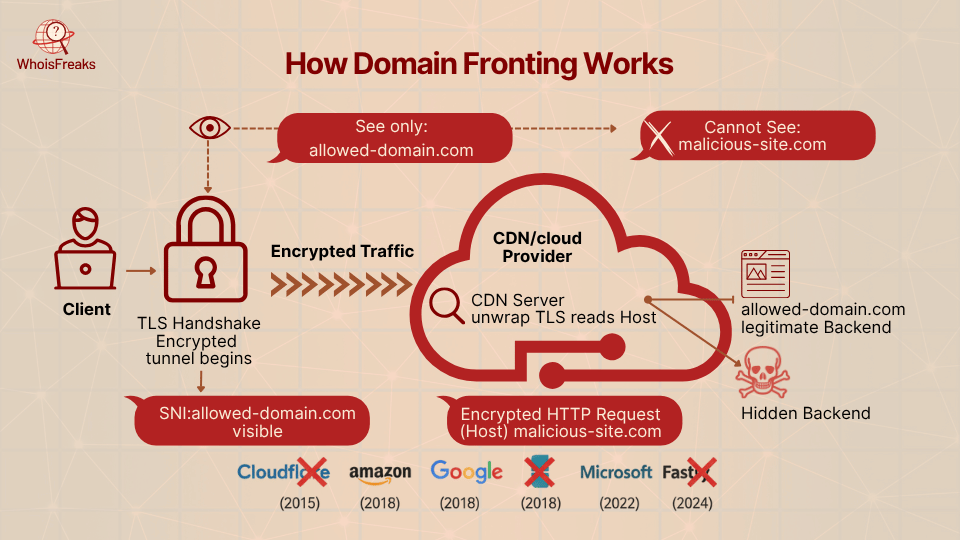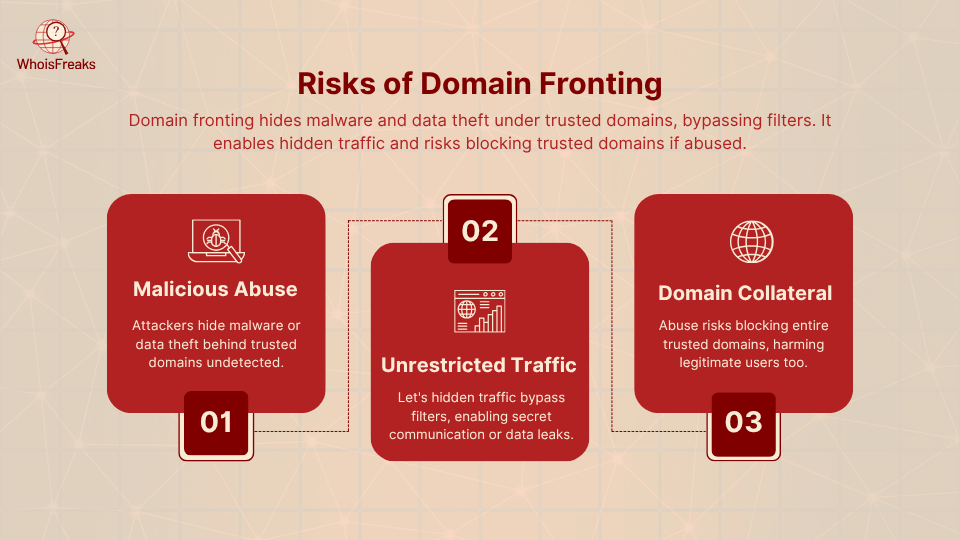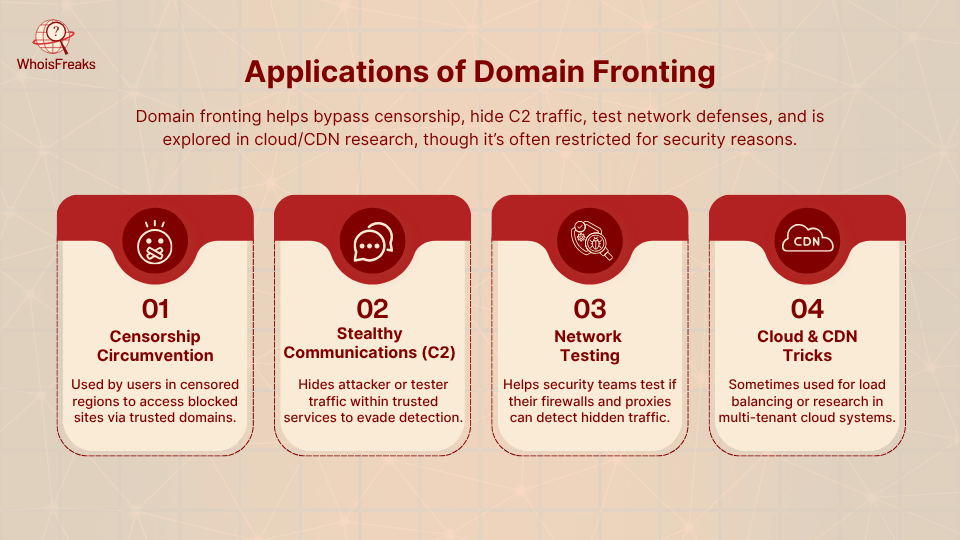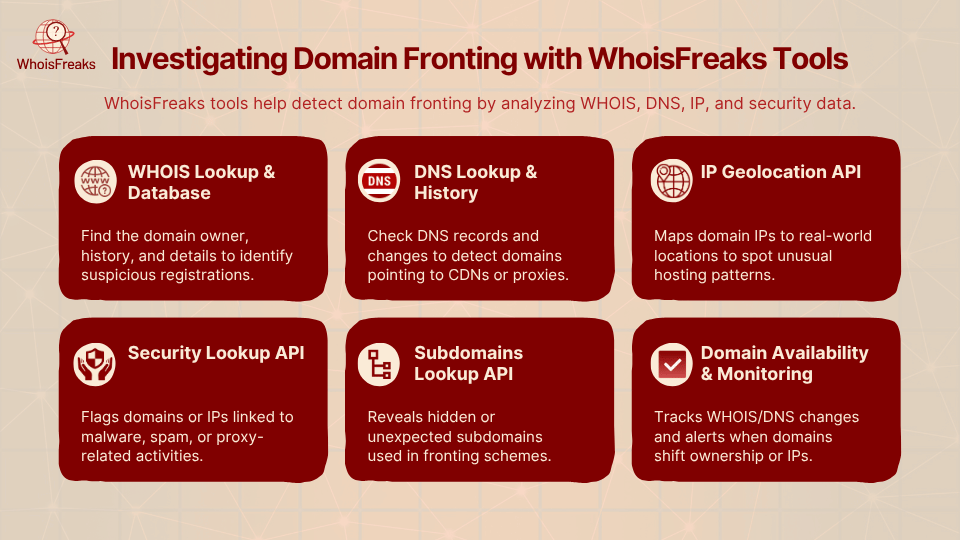
Understanding Domain Fronting: Benefits, Risks, and Applications
Domain fronting is an advanced network obfuscation technique that hides the true destination of HTTPS traffic by “fronting” it with a trusted domain. In practice, the client initiates a TLS connection using one domain name the SNI "Server Name Indication" while the actual HTTP request inside the tunnel uses a different Host header for the real (often hidden) domain. As a result, network filters or censors see only the front domain and cannot easily detect the blocked or malicious target. This technique has been used both by activists (to bypass censorship) and by threat actors (to mask command-and-control traffic).
In this blog post, we will explain what domain fronting is, how it works, and why it’s both powerful and problematic. We’ll also show how domain intelligence tools like WhoisFreaks can help analysts investigate suspicious fronting domains through comprehensive DNS query results.
What is Domain Fronting?
Domain fronting is a technique in which a client hides the true destination of an HTTPS request by using a different “front” domain in the TLS handshake than the actual backend domain specified in the Host header. In other words, the attacker sets the TLS SNI field to a legitimate, high-reputation site but puts the real target’s domain in the encrypted HTTP Host header. Because the Server Name Indication is sent in cleartext during the TLS handshake, the connection looks normal at first. Once the secure tunnel is established, the server uses the hidden Host header to deliver content from the true backend.
How Domain Fronting Works
Domain fronting exploits the fact that TLS and HTTP use separate host fields. In a fronted connection:

- TLS Handshake (SNI): The client uses the front domain in the SNI field. This field is sent unencrypted during the TLS handshake and determines which certificate the server presents. For example, the SNI might be allowed-domain.com (a popular, whitelisted site).
- Encrypted HTTP Request (Host): Inside the now-established TLS tunnel, the client’s HTTP request carries the hidden domain in the Host header. For instance, after connecting to allowed-domain.com, the client could request a resource from malicious-site.com by setting Host: malicious-site.com in the HTTP header.
- CDN Routing: Because many domains are hosted on the same CDN or cloud service, the server (front-end) will unwrap the TLS and see the Host header. It then routes the request to the backend content that corresponds to malicious-site.com. To anyone monitoring only the initial connection, the traffic looks like harmless usage of the front domain, but the CDN secretly delivers content from the hidden site.
This mismatch of SNI and Host allows clients to “mask” where their traffic really goes. Major service providers originally supported this quirk of CDNs, but many have since disabled it due to abuse of their CDN service. For example, providers like Cloudflare (2015), Amazon (2018), Google (2018), Microsoft (2022), and Fastly (2024) have moved to block mismatched hostnames in requests from a CDN server. Nonetheless, clever attackers and even legitimate apps have found ways to use domain fronting wherever it’s still possible.
Benefits of Domain Fronting
Despite its controversial nature, domain fronting offers certain advantages to users who need it to bypass censorship filters. These include:

- Bypassing Censorship: Domain fronting allows users in restricted or censored environments to access blocked content. Because the front domain is whitelisted (e.g., a major CDN or service), network filters let the traffic through, unaware that the request is for a hidden site. As one security guide notes, users often employ domain fronting “to access blocked content” when behind oppressive censorship.
- Evasion of Detection: Threat actors and privacy advocates alike appreciate that fronting makes malicious or private traffic appear as normal. For example, malware can use a popular domain (like google.com or aws.com) as the front, hiding the command-and-control endpoint in the Host header. This “masks” the true destination and helps evade signature-based detection or firewall rules.
- Leverage Trusted Infrastructure: Because domain fronting uses the large, trusted infrastructure of major CDNs and cloud services, it blends in with everyday traffic. Security tools and proxies often assume TLS connections are headed where their SNI says, so fronting exploits that trust. In fact, one expert points out that domain fronting utilizes the trusted infrastructure of Content Delivery Networks (CDNs), making the obfuscation incredibly difficult to detect.
- Resilience and Redundancy: In some scenarios, legitimate users can benefit from domain fronting to maintain connectivity. For instance, if a service is blocked under its normal domain, fronting can allow continued access via a different hostname.
Risks of Domain Fronting
The same properties that make domain fronting useful for defenders also make it dangerous when abused. Key risks include:

- Malicious Abuse: Attackers can easily exploit domain fronting to hide malware communications or data exfiltration. As one analysis warns, domain fronting lets “attackers masquerade potentially malicious activity as authentic, whitelisted traffic,” bypassing corporate egress filters and firewalls. This means organizations might be unknowingly allowing botnets, data breaches, or C2 channels under the guise of trusted domains.
- Unrestricted Traffic: Because fronting can slip past filters, it opens a blind spot. Malicious tools or malware inside a network might reach forbidden servers without alerting defenders. For example, it is now trivial for an attacker to “sign up and create their own HTTPS service” on a major CDN and use it to download hacking tools or upload stolen data. Another report notes that malware could communicate with a C2 server “without your knowledge” simply by hiding it under a front domain.
- Domain Collateral: Fronting leverages high-reputation domains; if abuse is detected, the whole domain could be blocked. Indeed, providers have already started disabling fronting to prevent collateral damage. For example, Google and Amazon removed fronting support in 2018 to avoid having to block all their domains if one service was abused. If a fronting abuse campaign is discovered, legitimate users of the front domain might suddenly lose access.
Applications of Domain Fronting
Domain fronting has been used in a variety of contexts:

- Censorship Circumvention: Political dissidents, journalists, and privacy-conscious users in censored countries have historically used domain fronting to reach blocked social media, news sites, or messaging platforms. By pretending to visit a major CDN or cloud service, they can tunnel requests to the forbidden site. In this way, fronting became a tool for free speech.
- Stealthy Communications (C2): Security researchers and cybercriminals alike use domain fronting to hide malicious command-and-control channels. In penetration tests, red teams have demonstrated tunneling traffic through core internet services (like Google or Zoom) to escape network monitoring. Likewise, advanced malware families may use fronting to contact their controllers without setting off alarms. By routing through a trusted service, the attacker’s traffic appears innocuous.
- Network Testing: Domain fronting is also used as a test for security setups. Because it can circumvent many proxy and firewall configurations, defenders sometimes deliberately try fronting techniques to check if their filters truly inspect both SNI and Host. This helps admins understand whether their egress controls can be bypassed.
- Cloud and CDN Tricks: Some legitimate services have considered fronting-style techniques for load balancing or multi-tenant hosting, although strict compliance has curtailed this. Innovative research continues.
Investigating Domain Fronting with WhoisFreaks Tools
Detecting domain fronting or analyzing suspicious domains requires good domain intelligence. WhoisFreaks offers a range of tools and data feeds that are highly relevant for this purpose. Their WHOIS and DNS services can help analysts uncover hidden domains and assess their trustworthiness. For example:

- WHOIS Lookup and Database: WhoisFreaks provides WHOIS tools to check domain ownership and registration details. Its database shows information like the owner, email, country, and registration history for millions of domains. Analysts can use it to find who registered a suspicious domain, see when it expires, and track past changes. The bulk lookup feature allows checking multiple domains at once for quicker analysis.
- DNS Lookup and History: WhoisFreaks’ DNS tools, like the DNS Lookup API, show a domain’s current DNS records. If a domain points to an IP owned by a major CDN, it may indicate domain fronting. The database also tracks historical DNS data, helping analysts spot recent changes in A, NS, or MX records. A sudden shift from a normal IP to a known proxy could signal suspicious activity.
- IP Geolocation API: After resolving a domain’s IP, WhoisFreaks’ Geolocation API can map that IP to a real-world location (country, city). If a domain is registered in one country but served from a data center halfway around the world, that could be suspicious or indicate use of cloud infrastructure. Geolocation data also helps identify if the IP falls into an unusual subnet or known hosting range.
- Security Lookup API: This tool classifies an IP or domain against threat intelligence feeds. For example, if the hidden domain’s IP has been flagged for spam, malware, or proxies, the Security Lookup API would return that risk level. A fronting domain that resolves to an IP marked malicious is a red flag. By combining WHOIS info with security scores, analysts can prioritize which domains to block or monitor.
- Subdomains Lookup API and Database: Attackers often use several subdomains in fronting schemes. WhoisFreaks’ Subdomains Lookup API helps analysts find all known subdomains of a suspicious domain. Uncovering unexpected subdomains can reveal more of the fronting setup. The Subdomains Database also allows ongoing monitoring to detect misconfigurations and prevent future attacks.
- Domain Availability and Monitoring: While not specific to fronting, the Domain Availability API lets defenders see if a potentially related domain is still unregistered. For instance, an attacker might try variations of a domain as fronts. Also, WhoisFreaks offers domain monitoring services that alert you when a domain’s WHOIS or DNS records change. If a legitimate front domain suddenly changes ownership or points to different servers, it might be used for fronting and trigger an alert.
Together, these tools give a security analyst a comprehensive view. For example, an investigator might start by using WHOIS Lookup to retrieve the registrant of the suspected fronting domain. Then they use DNS Lookup to see that it resolves to a CloudFront IP. The Geolocation API shows that IP is in Virginia (USA) even though the domain was registered in another country, which is unusual. The Security Lookup flags that IP as previously hosting malware.
Conclusion
Domain fronting is a clever but risky technique. It can help people access restricted content or keep their online activity private in the face of internet censorship, but it can also be used by attackers to hide harmful actions, often leveraging HTTPS encryption. Because it mixes trusted and hidden traffic, it’s not always easy to detect, which makes understanding it so important.
Tools like WhoisFreaks make it easier to uncover what’s really going on behind a domain. With its WHOIS data, DNS lookups, and security checks via a secure web gateway, you can see who owns a domain, where it’s hosted, and whether it’s linked to any suspicious activity to filter traffic effectively.
Staying alert to domain fronting and the implications for network traffic isn’t just for cybersecurity experts; it’s for anyone who values safe and transparent online connections.
Take action today: Visit WhoisFreaks.com to explore their domain investigation tools and strengthen your understanding of how domains work. The more you know, the safer your digital world becomes.
FAQs
1. How do you check for domain fronting?
You can check for domain fronting by comparing the SNI (the domain in the TLS handshake) with the Host header inside the HTTPS request if they don’t match during the same HTTPS connection, fronting might be happening.
2. How can we protect against domain fronting?
Use security tools or firewalls that inspect both SNI and Host headers and block any mismatched requests coming from the TLS server or suspicious domains.
3. What is the domain name in VPN?
It’s the server address your VPN connects to usually a web-style name like vpn.example.com, that hides your real IP and location.
4. How do we use a domain?
A domain is used to make websites easy to reach you register it, link it to your web server, and people can visit your site using that name instead of a long IP address.

Software Engineer
A software engineer focused on developing scalable, efficient solutions. Expertise in coding, system optimization, and utilizing advanced technologies for high-performance apps.
Related Posts

Essential Strategies to Prevent Subdomain Takeover...
Learn how to prevent subdomain takeover with essential strategies and best practices. Protect your online assets—read the full guide now!
Published at: Nov 18, 2025

Understanding Spear Phishing: Key Insights and Pre...
Learn about spear phishing: its types, risks, and effective prevention strategies to safeguard your digital life. Read more to protect yourself today.
Published at: Nov 10, 2025

Understanding Cache Poisoning: Risks and Preventio...
Learn about cache poisoning risks and effective prevention strategies to safeguard your online presence. Read the article to protect your systems toda...
Published at: Nov 5, 2025